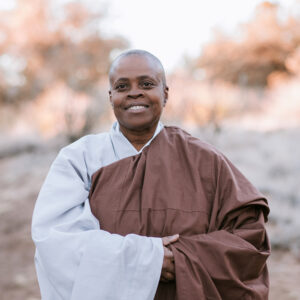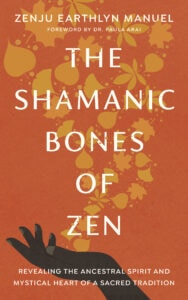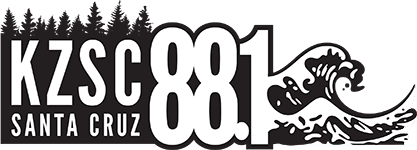
“The Shamanic Bones of Zen” – Interview with Zenju Earthlyn Manuel by John Malkin (May 19, 2022)

“The Shamanic Bones of Zen” Embraces Indigenous Roots and Rituals
By John Malkin — “The Shamanic Bones of Zen: Revealing the Ancestral Spirit and Mystical Heart of a Sacred Tradition” is the new book by Zenju Earthlyn Manuel. Published in February, 2022 by Shambhala Publications, the book dives deeply into the indigenous and mystical roots of Zen Buddhism. Zenju asks us to, “Consider the indigenous beginnings of all cultures” and submits, “There are underlying esoteric, mystical, or shamanic, histories to all spiritualities and religions.”
Zenju is an ordained Zen Buddhist priest who previously led the Kasai River Healing Sangha in Oakland, California and now lives in New Mexico where she leads the Still Breathing Zen Sangha, which she says was established at a time of “increased anti-blackness in this country.” For many years Zenju has also practiced singing, drumming and ceremonies from a variety of indigenous traditions including Caribbean, Native American Lakota and Vodou from Dahomey, Africa. She writes, “I wondered: if the shamanic bones or indigenous roots that were suppressed in the rising of Buddhism were unearthed, would the practice make more sense to practitioners, especially to black, indigenous and people of color?” Some of Zenju’s other books include “Sanctuary” and “The Deepest Peace.”
JOURNEY OF THE SPIRIT
JM: “You write that, “I experienced Zen practice as a shamanic journey of the Spirit.”
Zenju: “When I entered Buddhism, even chanting “Nam-myoho-renge-kyo” felt to be something very shamanic. It’s from the Soka Gakkai Nichiren Buddhist tradition,” Zenju explains. “I chanted this mantra and watched my life change from doing just that. It was a great experience of learning shamathah (concentration) without a lot of Buddhist dogma. I did that for fifteen years!
PEOPLE OF COLOR RETREAT
JM: “How did you come to Zen Buddhism?”
Zenju: “I had been doing silent meditation on my own and a friend invited me to a people of color retreat at Spirit Rock. I didn’t go. It didn’t make sense to me. Because where I was in East Oakland, we were all people of color! My whole sangha was black women!” Zenju continued, “Later, in 2002, I did go to an African American retreat and I saw these two Zen practitioners, who I thought were teachers. There was something about how they presented their talks that struck me. It wasn’t what they said. It’s how they bowed to their seat, how they sat up, spoke, how they got down off their seat. I said, “I want that.” So, I ended up checking out Berkeley Zen Center. When I got there, they said, “There’s a people of color group over at San Francisco Zen Center.” And again, I was like, “I’m not getting it! What’s this people of color group?”! I went with a friend to San Francisco Zen Center and did join the people of color group. My friend ended up leaving Zen and I went deeper into it. I did an intensive three-week retreat and I came out a different person. I felt at ease with my life. I considered entering Thich Nhat Hanh’s monastic Order of Interbeing but I was too old. I think you have to be between sixteen and thirty to become ordained. When he passed away, I was telling my students, “The oldest people you see at the funeral ceremony have been with Thich Nhat Hanh their whole lives. They were sixteen together.” Can you imagine being sixteen years old, and then being ninety-something, together, burying your ninety-five-year-old brother? Now that’s sangha!” (community)
ENGAGED BUDDHISM
JM: “Vietnamese Zen master Thich Nhat Hanh has been so important to me. His practice of engaged Buddhism is revolutionary, acknowledging that it’s not enough to sit in the meditation hall if there are bombs dropping outside, or children who need food. Sometimes direct action is necessary. He came to the U.S. to try to stop the war that was devastating his country.”
Zenju: “Thich Nhat Hanh was definitely a great teacher. I had my students listen to “A Cloud Never Dies.” I get a little perturbed sometimes when people talk so much about the Dalai Lama and not so much about Thich Nhat Hanh. I tell people that sit with me, “Do you know why they don’t talk about Thich Nhat Hanh? It’s because he came out against our war! And then he still built a counterculture religion in a Christian country!” He’s amazing,” Zenju reflects. “He was among a group of young people who wanted to create a new kind of Zen. He knew it had to be something engaged. And it didn’t mean what we have today with, “Now we’re going to go protest the war in Ukraine.” No, it was about what’s outside your own door. What bomb is dropping outside your door, in your own city?”
VODOU & ZEN
JM: “At one point you told one of your Zen teachers, “Vodou and Zen are the same.” It didn’t resonate for your teacher.”
Zenju: “When you’re doing the rituals and practices of Vodou, just like in Zen, you’re discovering life and discovering yourself. That’s the link between the two. Vodou embraces all of life, just like Zen. It has the same principles as Zen. What’s different are the specific rituals and ceremonies, and how you come to understand nature and life. A lot of the Vodou dances are about protection, upholding a wholesome good life, healing. It’s always made out that Vodou is done to hurt somebody and has nothing to do with wellness. It’s just the opposite,” Zenju offers.
“I am completely called to Vodou because I’m a descendant of Africans who were taken away from their home. After that, most of us were unable to fully practice our indigenous practices. But I think there’s some imprints in us that call us to particular African indigenous practices. For me, it’s been Vodou. Vodou means spirit. I’ve gotten a lot of information by drumming. I’m a drummer. That is far from sitting, but it’s very concentrated. The sounds and the rhythms open you up just as much as sitting. Stillness and quiet is not the only way. Whatever that thing is that opens you, you have to find it.”
EVEN CHURCH IS SHAMANIC
JM: “You write that, “Zen leaned away from rituals and acknowledging itself as shamanic for fear of being mistaken for new age, witchcraft or Vodou.” It seems to me that anti-ritual attitudes are rooted in a modern Western belief that indigenous practices are backwards and need to be refined. And this belief has supported colonialism, racism and violence.”
Zenju: “When people say, “I don’t want to do a ritual, I don’t like ceremony, I just do Zen,” then there’s something in there. When people say they dislike something primal, it’s because they associate it with being uncivilized. It’s like what we see in movies with the ways indigenous cultures are depicted. That’s what I’m asking people to look at,” Zenju explains.
“None of that has come up in any of the interviews I’ve had so far. And that’s one of the most important things in my book! So, I’m glad we’re talking about it. One guy said, “I heard you talking about all these different rituals, but the focus of Zen is just zazen.” And I said, “Yeah, that’s the biggest ritual of them all!” I’m thinking, “What happened in your mind, in which you could not hold that zazen is a ritual?” If we can release our negative ideas about ritual and ceremony, we can begin to see a more integrated way.
Even church is shamanic! Eating a cracker for the body of Jesus Christ and drinking grape juice for his blood? Completely shamanic! Mostly, Zen is a lot of incense and flower offerings and eating. It reminded me of how church was for me; everybody’s in church together, babies and old folk. A Buddhist abbott asked me what kind of Zen Center I would establish and I said, “Well, there’d be a lot of children and grandparents, music and a whole lot of food.” And he said, “Wow! That’s how they do it in Thailand!” I said, “Yeah, that’s kind of how colored people do it.” Everywhere you go, in every practice, the whole community’s there.”
SYSTEMIC OPPRESSION
JM: In “Shamanic Roots of Zen,” you write, “There is no religion or spiritual community in the United States that is without systemic oppression.” And, “Beginning very early in the colonial era, there have been violent efforts, including the annihilation of African and Native American medicine people, and the burning of those accused as witches to suppress that which was viewed as magic.”
Zenju: “There are political and social ramifications of not respecting indigenous ritual. Not understanding it, or respecting it, can lead to some horrific experiences like genocide, massacre, slavery and things like this. We were hoping things wouldn’t go back to “normal” after the pandemic. And there is no way for us to go back. But what’s happening now is that the social structures are still there and they’re still crumbling. We’re trying to fit ourselves back into the structures but we ourselves have changed. We’re still in these structures because we didn’t build anything new. Over time, things will begin to show themself, but we have to take time to be in the darkness,” Zenju said.
“My next book is called “Opening to Darkness: Eight Gateways for Being with the Absence of Light in Unsettling Times.” It’s coming out in March, 2023. I’m bringing all of my transmissions in this book; Vodou and Buddhism. It’s integral because we are in an integral world. None of us are only that or only this. And it’s hard for us to be with darkness. We long for the light. Now, it’s mask on, mask off, mask on. Okay, wear a mask, period! This pandemic is ongoing. It doesn’t matter if you had a shot, or you had Covid; put your mask on if you’re not feeling well. Try to protect others – that should be a new way of being! This is something we’re learning. And it’s transitional. Everything’s transitional.”
This interview with Zenju Earthlyn Manuel was originally published in the Santa Cruz Sentinel and broadcast on KZSC 88.1 FM on Thursday, May 19, 2022.

